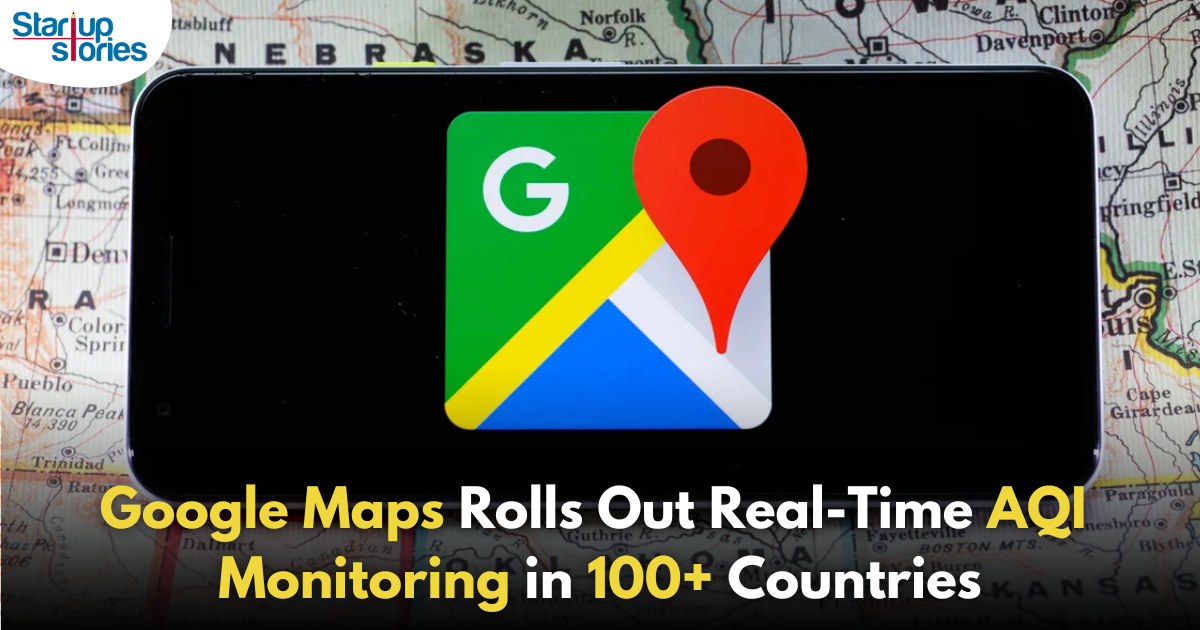Latest News
Google Maps Rolls Out Real-Time AQI Monitoring in Over 100 Countries Ahead of Winter!

Google Maps has introduced a groundbreaking feature that allows users to monitor real-time Air Quality Index (AQI) levels directly within the app. With over 2 billion active users worldwide, this update provides live AQI data along with practical health tips based on air quality conditions, particularly as winter approaches—a season often associated with declining air quality.
Real-Time AQI Updates
The new AQI feature updates hourly, enabling users to check air quality in specific areas across India and more than 100 other countries starting this week. The feature presents the AQI as a single, easy-to-read value calculated based on various pollutants in the air, using a scale that ranges from 0 to 500. Google Maps categorizes AQI levels as follows:
- 0-50: Good (Green)
- 51-100: Satisfactory (Yellow)
- 101-200: Moderate (Orange)
- 201-300: Poor (Red)
- 301-400: Very Poor (Purple)
- 401-500: Severe (Maroon)
Each category is represented by distinct colors, allowing users to quickly assess air quality at a glance.
Health Precautions Based on AQI
In addition to providing real-time data, Google Maps offers tailored health advice based on AQI levels, particularly for vulnerable populations. For instance, when the AQI reaches “severe” levels, the app advises against outdoor activities for the general public and recommends that at-risk individuals stay indoors. It also suggests using air purifiers for those in areas experiencing consistently poor or severe air quality.
How to Check AQI on Google Maps
To access AQI data on Google Maps, follow these simple steps:
- Open the Google Maps app on your device.
- Tap on the “layers” icon, typically located in the upper-right corner.
- Select the “Air Quality” layer to view the AQI for your current location or any area you plan to visit.
This new feature serves as a valuable resource for users to stay informed about air quality and take necessary precautions to protect their health, especially during winter months when air pollution can be a significant concern.
Broader Implications of Real-Time AQI Monitoring
The introduction of real-time AQI monitoring aligns with growing global awareness of air quality issues and their impact on public health. Poor air quality is linked to various health problems, including respiratory diseases and cardiovascular issues. By integrating this feature into Google Maps, the company empowers users to make informed decisions about their outdoor activities and overall well-being.
Conclusion
As Google Maps rolls out this essential feature ahead of winter, it not only enhances user experience but also contributes to public health awareness. With real-time access to air quality data and actionable health recommendations, users can better navigate their environments and protect themselves from the adverse effects of pollution. This initiative underscores Google’s commitment to leveraging technology for improved health outcomes and environmental awareness globally.
Latest News
Centre Mulls Revoking X’s Safe Harbour Over Grok Misuse

The Centre is weighing the option of revoking X’s safe harbour status in India after its AI chatbot Grok was allegedly misused to generate and circulate obscene and sexually explicit content, including material seemingly involving minors. The IT Ministry has already issued a notice to X, directing the platform to remove unlawful content, fix Grok’s safeguards, act against violators, and submit a detailed compliance report within a tight deadline. If the government finds X’s response inadequate, it could argue that the platform has failed to meet due‑diligence standards under Indian law, opening the door to harsher action.
Under Section 79 of the IT Act, safe harbour protects intermediaries like X from being held directly liable for user‑generated content, provided they follow due‑diligence rules and promptly act on legal takedown orders. Revoking this protection would mean X and its officers could be exposed to criminal and civil liability for obscene, unlawful, or harmful content that remains on the platform, including AI‑generated images from Grok. This prospect significantly raises X’s compliance risk in India and could force tighter moderation, stricter AI controls, and more aggressive removal of flagged posts.
The Grok episode also spotlights the regulatory grey zone around generative AI, where tools can create harmful content at scale even without traditional user uploads. Policymakers are increasingly questioning whether AI outputs should still enjoy the same intermediary protections as conventional user posts, especially when they involve women and children. How the government ultimately proceeds against X over Grok misuse could set a precedent for AI accountability, platform responsibility, and safe harbour interpretation in India’s fast‑evolving digital ecosystem.
Latest News
How Pronto Is Redefining 10-Minute Home Services in India with a $25 Million Fundraise

Home services startup Pronto is in advanced talks to raise about $25 million at a near-$100 million valuation, underscoring strong investor confidence in India’s fast-growing 10-minute home services market. This potential round would be the company’s third major funding milestone after its $2 million seed and $11 million Series A in 2025, backed by marquee investors such as General Catalyst, Glade Brook Capital, Bain Capital and new participant Epiq Capital. The fresh capital is expected to further strengthen Pronto’s positioning as a leading tech-led household help platform for urban consumers.
Pronto operates a 10-minute on-demand home-services platform that connects users with trained, background-verified workers for everyday tasks like sweeping, mopping, utensil cleaning, laundry and basic cooking. Using a hub-and-spoke, shift-based model, the startup stations workers at hyperlocal hubs, enabling sub-10-minute fulfilment and more predictable earnings compared to the informal domestic-help market. Founded in 2024 by Anjali Sardana and based in Delhi NCR, Pronto has already expanded from Gurugram into major cities such as New Delhi, Mumbai, Bengaluru and Pune, and is handling around 6,000 daily bookings with nearly 1,300 active professionals as of December 2025.
The upcoming $25 million fundraise is expected to be used to enter more metros, deepen presence in existing neighbourhoods with additional hubs and upgrade Pronto’s technology for smarter routing, shift planning and real-time operations. A significant portion of the capital will also go into training, retention and benefits for its workforce to maintain consistent service quality at scale, especially as competition heats up from rivals like Snabbit and Urban Company in the rapid home services space. This near-$100 million valuation not only validates Pronto’s model but also highlights a broader shift toward organised, tech-driven domestic-help solutions in India’s largely informal home-services market.
Latest News
Bhavish Aggarwal Sells ₹325 Crore Ola Electric Stake, Retains Control

Bhavish Aggarwal has sold Ola Electric shares worth about ₹325 crore over three consecutive trading sessions, primarily to fully repay a promoter-level loan of ₹260 crore and release all pledged promoter shares. Despite the stake sale, he continues to hold a significant shareholding of over 34 percent in Ola Electric, and the company has clearly stated that there is no change in promoter control or his long-term commitment to the business. This one-time, limited monetisation at the promoter’s personal level is positioned as a structural clean-up rather than a signal of reduced confidence in the company.
The transactions, executed through open-market bulk deals, included an initial sale of about 2.6 crore shares worth roughly ₹92 crore at an average price of ₹34.99 per share, followed by additional trades of around ₹142 crore and ₹90 crore, taking the total sale value to approximately ₹324–325 crore. As a result, Aggarwal’s stake has fallen by a little over 2 percent, while all previously pledged promoter shares about 3.93 percent of Ola Electric’s equity are being released, removing the overhang and risk typically associated with pledged stock. The company has also clarified that these deals do not involve any capital raise or dilution by Ola Electric itself, which is important for investors tracking promoter stake and governance.
The share sale came at a time when Ola Electric’s stock had been under pressure, even hitting an all-time closing low amid concerns around growth, competition and heavy promoter selling. However, once the company confirmed that the stake sale was complete and all promoter-level pledges would be cleared, the stock rebounded sharply, gaining around 9–10 percent as markets welcomed the removal of this technical overhang. For investors, the focus is now expected to shift back to Ola Electric’s core fundamentals EV sales growth, margins, and market-share performance in India’s two-wheeler EV segment while the reduced promoter debt risk and continued high promoter holding offer some comfort on long-term alignment.














xvideos
January 17, 2025 at 7:57 am
Veery nie bllog post. I cerftainly appreciate thiss website.
Thanks!
bezplatn'y úcet na binance
March 25, 2025 at 9:40 pm
Your article helped me a lot, is there any more related content? Thanks! https://accounts.binance.com/de-CH/register-person?ref=UM6SMJM3
xnxx
June 28, 2025 at 2:29 am
Thamks , I’ve juxt een searching for information abokut this topic for a while and yours iis the est I have cane uplon sso far.
But, what in regards tto tthe conclusion? Arre you certain bout thee supply?
Prihlásit se a získat 100 USDT
August 28, 2025 at 6:25 pm
Can you be more specific about the content of your article? After reading it, I still have some doubts. Hope you can help me. https://www.binance.com/id/register?ref=GJY4VW8W
binance referral bonus
October 5, 2025 at 10:11 pm
Thank you for your sharing. I am worried that I lack creative ideas. It is your article that makes me full of hope. Thank you. But, I have a question, can you help me?
binance
October 16, 2025 at 1:39 pm
Thank you for your sharing. I am worried that I lack creative ideas. It is your article that makes me full of hope. Thank you. But, I have a question, can you help me?
MM88
November 5, 2025 at 12:10 pm
Khám phá thế giới giải trí trực tuyến đỉnh cao tại MM88, nơi mang đến những trải nghiệm cá cược thể thao và casino sống động.
谷歌站群
November 7, 2025 at 11:29 am
专业构建与管理谷歌站群网络,助力品牌实现全域流量的强势增长。谷歌站群
J88
November 7, 2025 at 6:01 pm
Đến với J88, bạn sẽ được trải nghiệm dịch vụ cá cược chuyên nghiệp cùng hàng ngàn sự kiện khuyến mãi độc quyền.
站群程序
November 8, 2025 at 12:59 pm
采用高效谷歌站群策略,快速提升网站在搜索引擎中的可见性与权重。谷歌站群
Kuwin
November 13, 2025 at 7:08 am
kuwin sở hữu kho game đa dạng từ slot đến trò chơi bài đổi thưởng, mang đến cho bạn những giây phút giải trí tuyệt vời.
ios超级签
November 13, 2025 at 3:15 pm
苹果签名,苹果超级签平台,ios超级签平台ios超级签苹果企业签,苹果超级签,稳定超级签名
GO88
November 21, 2025 at 1:03 pm
Tham gia cộng đồng game thủ tại Go88 để trải nghiệm các trò chơi bài, poker phổ biến nhất hiện nay.
iwin
November 25, 2025 at 12:18 am
iwin – nền tảng game bài đổi thưởng uy tín, nơi bạn có thể thử vận may và tận hưởng nhiều tựa game hấp